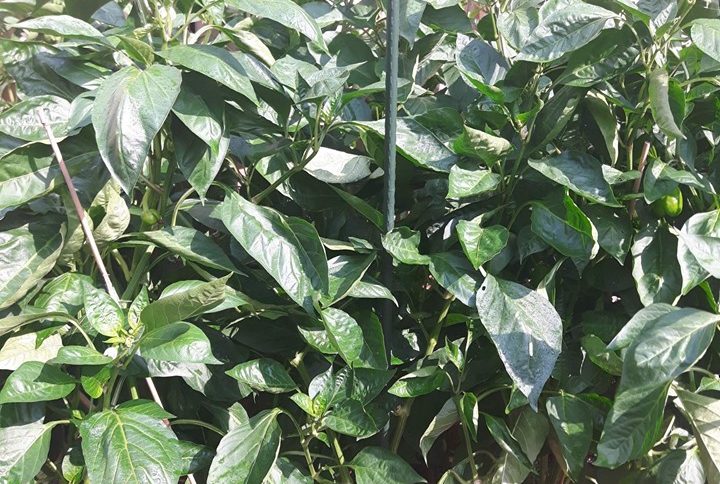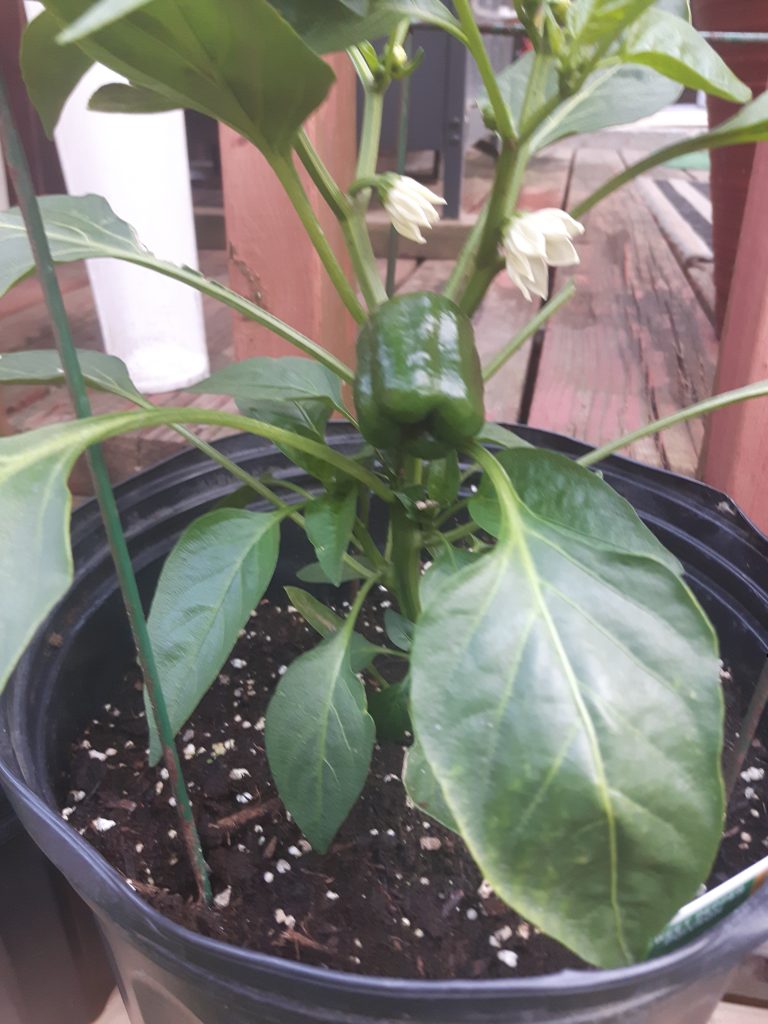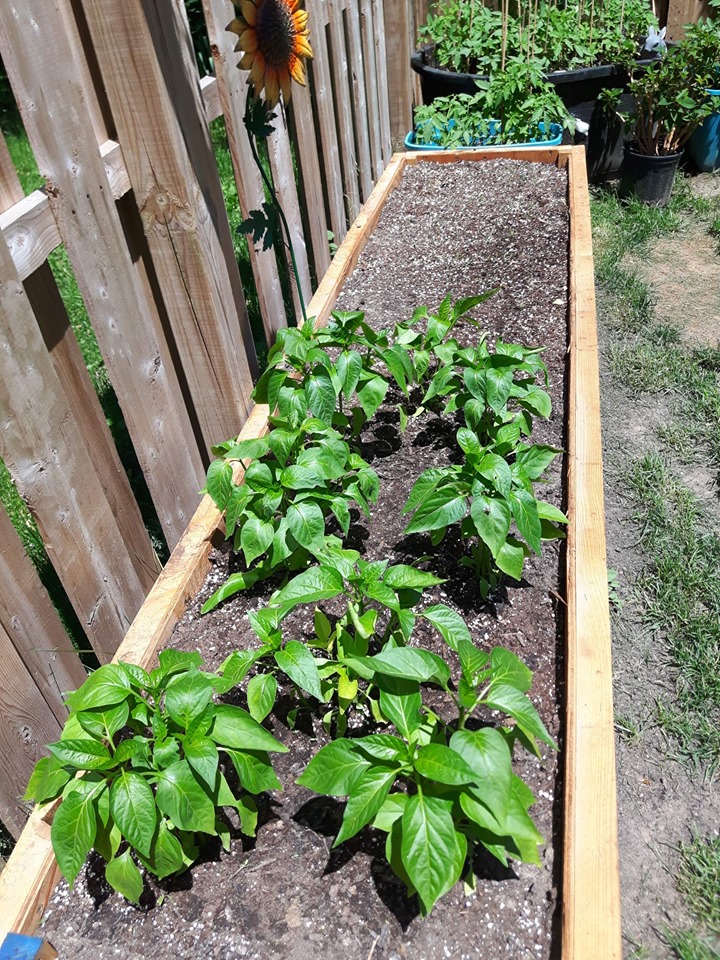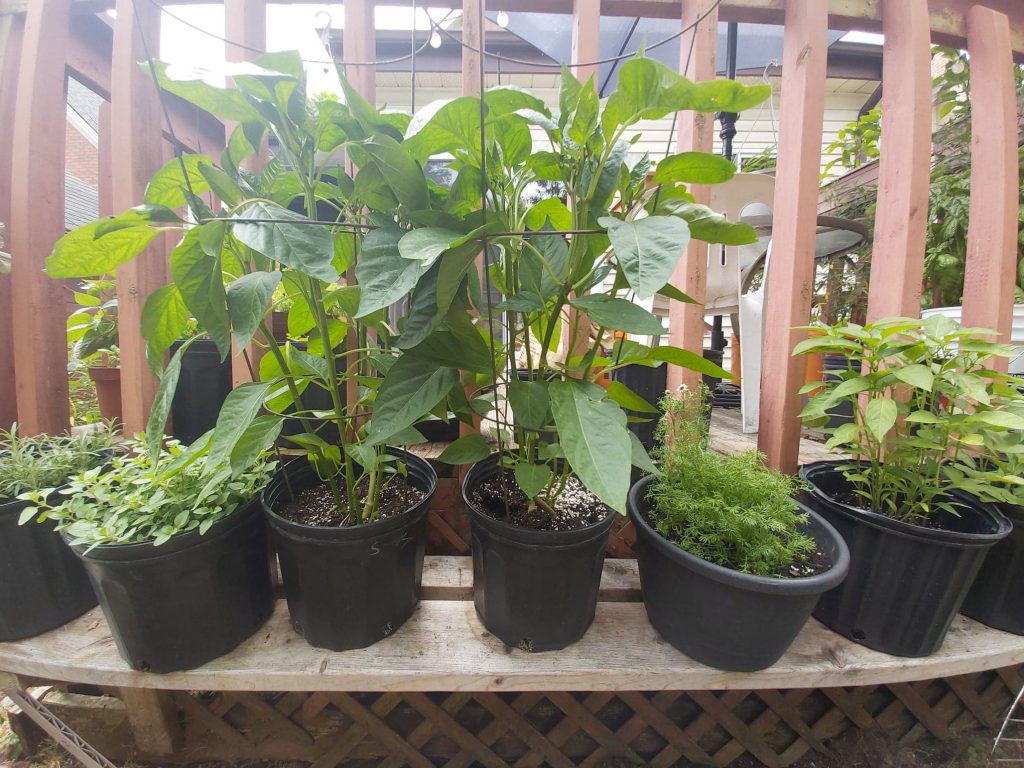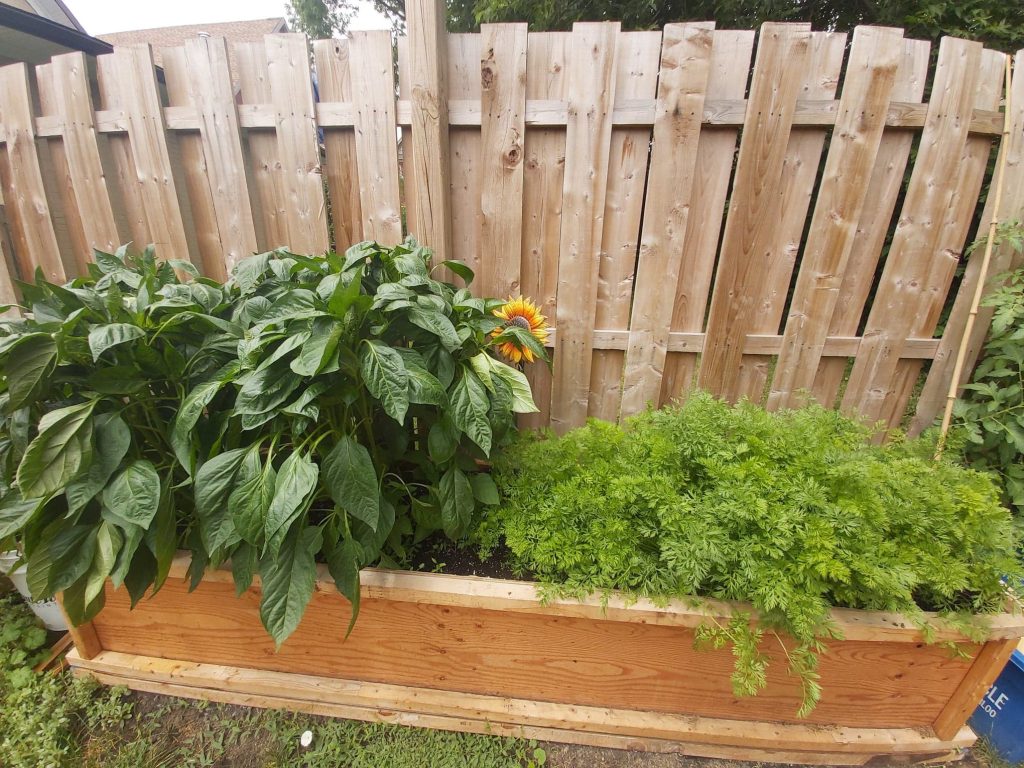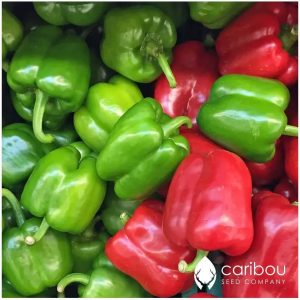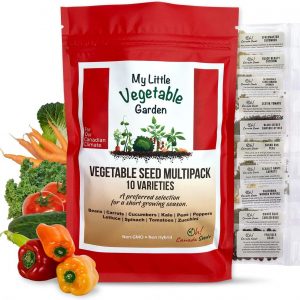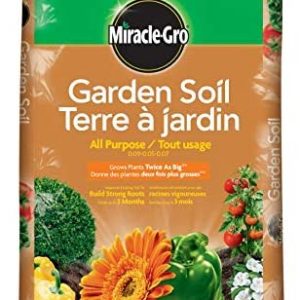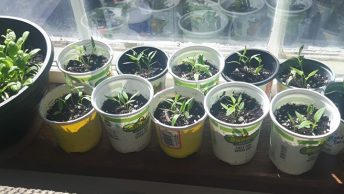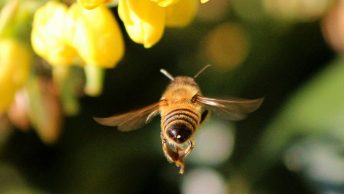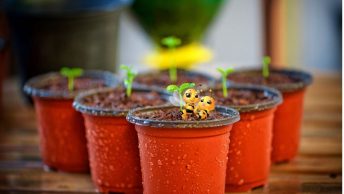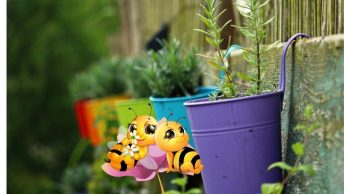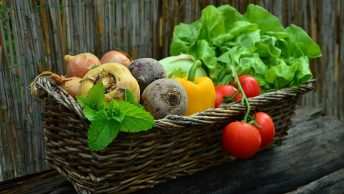The Best Containers to Grow Bell Peppers are actually larger ones where you can fit a few plants in at a time. I for example have grown them in pots where I would yield about 5-6 Peppers per plant throughout the season. It really wasn’t much. My husband built me some great containers this last year to accommodate my cucumbers and my bell peppers. Take a look here is the one in pots:
Table of Contents
Growing Bell Peppers In Pots
You can see from the picture you will get flowers and peppers growing all summer long. Make sure you pick them at a medium size so the plant can produce more flowers and peppers. My worst yield from one pot was 5 peppers. I have managed to get 10 per plant if I keep the soil moist and use the Miracle Gro Moisture control.
Growing Bell Peppers in a Larger Container
I used a container this size and only planted 7. You won’t believe what I yielded! I had to freeze 11 freezer bags of chopped peppers. Not to mention I jarred some with the hot peppers. We had so many I really couldn’t believe it. So if you eat a lot of bell peppers I suggest doing a larger container! I don’t think I will use this method this year since
Planting Your Bell Pepper Seeds

Getting Your Seeds From Your Bell Pepper On Hand
When you cut open a Bell Pepper you will see they contain many seeds in the middle. Don’t discard them. Rinse them off and place them on a paper towel to dry for a couple of hours. Then use small cups or containers and place your seed into the container about 1/4″ Deep. Keep watered so they do not dry out. In about 7-8 days you will see them pop out of the soil. I kept mine in the window because it was warm. They must start off in a warm sunny place away from drafts or cold.
When growing other peppers I have noticed a difference but Bell Peppers are not one of them.
How to Prune Your Bell Peppers
I suggest pruning your bell peppers twice. Once during the Early Season and once during the later season. Here is why and the difference:
Early Season Pruning Your Bell Peppers
Before the plant develops any fruit you want to keep in mind that you are pruning to allow more circulation and allow better access to sunlight. Doing this type of pruning does not give you more peppers. It just allows the plant to focus more on developing flowers and fruit.
How to Prune Your Peppers In the Early Season of Planting
This should not be done until the plant reaches at least 31cm tall. And can be stopped once the fruit starts to develop. You will see the stronger branches that create smaller “Y” looking branches. Cut back any suckers they grow between the Y just like tomato plants. Be very careful not to damage the backbone of that Y. Damaging this will cut your crop back. So take care when pruning.
How to Prune Your Peppers In the Later Season of Planting
I don’t recommend doing this until the growing season is almost over. You want the plant to focus on growing the fruit that it has already and getting rid of the flowers to encourage them to complete the growing cycle before the frost arrives. It will force the plants remaining energy to finish growing the smaller ones that are developing. Otherwise, you will have really small peppers when you finally do harvest before the frost. Trim back all the branches that have fruit on them as well.
Video on Pruning Your Bell Pepper Plants
Pests and Other Diseases When Growing Bell Peppers
There are three different types of problems you can have. They are:
- Fungal Diseases
- Virus Diseases
- Physiological Disorders like sunscald, fruit cracks, spots, etc.
Fungal Diseases
Powdery Mildew
Powdery Mildew can affect your pepper plants. The main cause is Leveillula Taurica. However, it is not a problem seen often in Canada. Only in 1999 two separate greenhouses in Ontario reported this issue. Which they lost 10-15% of their crops. Getting rid of Powdery Mildew is simple. Wipe each leaf daily until the mildew disappears using the following methods:
Methods to removing Mildew on any plants
First Method I recommend is:
Combine 1 tablespoon of baking soda with 1 tablespoon vegetable oil and 1 teaspoon of dish soap with 1 Gallon of water. Put into a spray bottle and spray onto your leaves, wipe them clean and give them another spray. I sometimes do this early on for my cucumber plants and zucchini plants. Remove really infected leaves and then proceed to use one of the following methods.
Preventing Mildew
Keep your plants spaced so they have plenty of circulation and sunlight. Do not overwater your plants. Plants grown in Ontario are prone to this because Mildew develops in Humid conditions. The spores love humidity and hate the rain and water. They cannot spread or germinate if the leaves are wet. Using these methods will not cure the plant. It only will stop spreading and or slow down the spreading process.
Method 2 for Mildew on Your plants is:
Mix 4 tablespoons baking soda with 2 tablespoons of Murphy’s Oil soap to 1 Gallon of water.
Method 3 for Mildew on your pepper plants:
Mix 2-3 tablespoons of vinegar with 1 gallon of water. I don’t use this method unless nothing else is working. The reason being is that vinegar can burn your leaves. So use with caution.
Method 4 for removing mildew on your plants
Neem Oil is an organic fungicide. Just follow the directions on the label.
Method 5 For removing mildew on any plants
Although it is NOT organic, mouthwash has been known to get rid of severe infestations. Mix 1 cup mouthwash to 3 cups of water.
Damping-off is another fungal disease Pepper Plants can have
This is a disease of the seedlings. It is caused by Pythium and Rhizoctonia solani. The disease attacks the young plants. Plants can still reach maturity with this disease. Since planting fresh seeds I have not had this issue. It is a great preventative measure by using fresh seeds.
Pythium Crown and Root Rot
It can occur as an extension of early damping-off. It develops slowly where the plant wilts and dies off slowly. The best way to prevent this is to ensure that you have optimal growing conditions. Root Zone tempeture and watering must be maintained properly to avoid this issue.
Fusarium Stem and Fruit Rot
The plant leaves will appear to have soft dark brown or black lesions on the stems right at the nodes or wound sites. Eventually, you will notice black lesions on your fruit. This is why it’s important not to damage the main stems. This can develop when humidity rises over 85%.
Gray Mold
Gray mold is caused by a fungus called Botrytis cinerea. Very common in greenhouses with high humidity and poor air circulation. You will notice the fungus enters into wounded parts of the plant. It has olive-like green lesions that can develop on the stem causing the plant to die.
Virus Diseases
There are a few types of virus diseases called:
- Pepper mild mottle virus (PMMV)
- Tomato spotted wilt virus (TSWV)
- Tobacco Mosaic Virus (TMV)
Pepper Mild Mottle Virus (PMMV)
First reported in Canada in 1985. The first confirmed case in Alberta was in 1998. This type of mildew is not visible until it develops fruit. Fruit symptoms are often mistaken for other problems like magnesium and manganese deficiencies. The new growth will look stunted, often you will see bumps on the fruit with a clear mosaic pattern of yellow or green. The fruit will also grow with pointed ends on them or sunken brown spots on the peppers.
Preventing this type of virus is using a routine skim milk bath for your leaves and plants. The proteins in skim milk bind to the virus and inactivate it. Peppers with symptoms should be discarded but you can still keep the plant alive to bear more healthy fruits.
Tomato Spotted Wilt Virus (TSWV)
The virus is spread primarily by western flower thrips and can cause a lot of damage to your plants. Symptoms are on the fruit that is ripening with dramatic orange and yellow spots on them surrounded by a green, yellow, or orange color. In Alberta pepper greenhouses they documented that one-third of the fruit from infected plants actually show symptoms. After maintaining a 6-meter weed-free buffer zone significantly decreased the problem.
Tobacco Mosaic Virus (TMV)
Similar to the Tomato mosaic virus (ToMV) it is not a common problem when growing peppers in Canada. This is when the leaves wilt and drop from the plants. Using disease-free seeds and removing any infected plants is your only option to preventing this virus.
Resources
Pepper Diseases Identification Pictures in Canada.
Conclusion of The Best Containers to Grow Bell Peppers
I suggest using larger containers if you would like to grow massive amounts of peppers. Use smaller pots to grow what you need for the summer. I can usually get a few jars of pickled peppers just from my pots. You can find a disease in any plant and identify it by using the GrowVeg Website. It is a fantastic resource. They even have an app that you can get direct advice through email on their app for specific topics and issues.
Using larger containers
Products I can recommend for Growing Your Bell Peppers
Basil Beans Beets Bell Peppers Carrots Cayenne Peppers Celery Chinese Eggplant Chives Cucumber Garlic Jalapeno Kale Lemon Lettuce Mint Onions Oregano Parsley Peas Potatoes Rosemary Sage Spinach Thyme Tomatoes Zucchini


